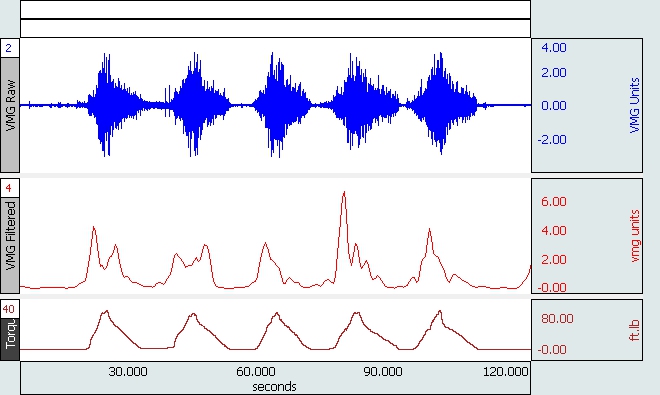Vibromyography (VMG) – Muscle Activity
Complete Systems for Muscle Monitoring Using Vibromyography
AcqKnowledge software includes automated VMG analysis filters to simplify the analysis process.
Study muscle performance and strength balance

Breakthrough VMG technology—capture muscle force data in real time
BIOPAC provides breakthrough Vibromyography (VMG) technology allowing researchers to capture muscle force data in real time. VMG transducers record vibration data received from microelectromechanical systems (MEMS) sensors and proprietary software. Researchers can then use BIOPAC’s world-class MP data acquisition and analysis hardware platforms and powerful and flexible AcqKnowledge software for additional analysis.
VMG provides extremely reproducible results. The single sensor solution and the lack of skin preparation improve the reliability and reproducibility of muscle effort recordings between muscles and across subjects. One major benefit of being able to compare results between muscles and between subjects is the ability to perform muscle balance assessments.
Try VMG tools in the free AcqKnowledge Demo
See More...
Hardware Packages | Vibromyography (VMG) – Muscle Activity
Hardware Bundles are complete solutions for the specified application. Choose your preferred platform and bundle, then click "Request Pricing" to request an estimate, add/remove items, or complete purchase. If you have questions about specific items, click through to the product web page for details and specifications, or contact your Local Sales contact.
Wired
-
MP36R System plus 2-channel VMG system
Wired | Vibromyography (VMG) – Muscle Activity
MP36R with AcqKnowledge plus 4-channel VMG system for vibromyography
-
MP36R System plus 2-channel VMG system
Wired | Vibromyography (VMG) – Muscle Activity
MP36R with AcqKnowledge plus 2-channel VMG system for vibromyography
-
MP160 System + 4-channel Vibromyography (VMG) System
Wired | Vibromyography (VMG) – Muscle Activity
MP160 with AcqKnowledge plus 4 channel VMG system
-
MP160 System + 2-channel Vibromyography (VMG) System
Wired | Vibromyography (VMG) – Muscle Activity
MP160 with AcqKnowledge plus 2 channel VMG system
MP36R System plus 2-channel VMG system
- 1 x Vibromyography Systems with MP36R
MP36R System plus 2-channel VMG system
- 1 x Vibromyography Systems with MP36R
MP160 System + 4-channel Vibromyography (VMG) System
- 1 x Vibromyography Systems with MP160
MP160 System + 2-channel Vibromyography (VMG) System
- 1 x Vibromyography Systems with MP160
Stay Connected